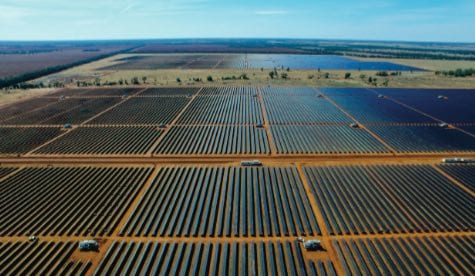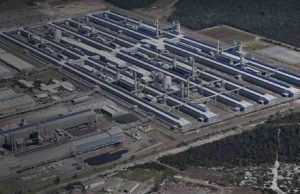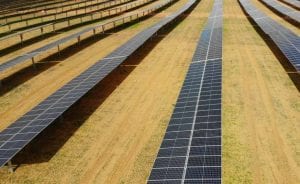The New South Wales Coalition government on Wednesday launched one of the most significant energy transition projects in Australia, with an Emerging Energy Program that is designed to help replace most of the state’s ageing coal plants with wind, solar and storage over the next 15 years.
NSW is the only state in the National Electricity Market without a specific or aspirational renewable energy target. But in its recent Integrated System Plan, the Australian Energy Market Operator highlighted the fact that the state was facing the biggest transition, because most of its 10GW of coal-fired generators were getting to the end of their life.
Within 15 years, AEMO predicts, 70 per cent of that coal capacity will be gone – and it expects this to be replaced by large-scale solar, large-scale wind, storage, and rooftop solar, with the share of gas and hydro little changed from today’s level. (See graphs below).
The NSW Emerging Energy Plan is designed to support the commercialisation of new large-scale projects in NSW that use emerging, dispatchable technology.
It is offering up to $10 million per project, for a total of $55 million. But it is not the scale of the initiative that is significant, it is the acceptance that the energy transition is profound, rapid and unstoppable.
“We are not seeking to accelerate the closure of coal-fired generators or delay their closure,” energy minister Don Harwin told RenewEconomy. “The transition is happening, this helps prepare us.”
The new initiative was launched by Harwin at an industry briefing – attended by some 400 people – at NSW Parliament House on Wednesday, and included presentations from AEMO chief executive Audrey Zibelman and Australian Renewable Energy Agency CEO Darren Miller.
The program will provide up to $10 million in capital funding per project, and up to $500,000 for feasibility studies. The projects must be grid-connected, at least 5MW in size, and provide “emerging and dispatchable” technology.
An emissions intensity cap of 0.5 tonnes of Co2-e has been placed on any projects. This effectively rules out coal – as the idea of “clean coal” is nothing but a marketing term. It may allow for some form of gas generation, but such projects may struggle to compete with the falling cost of wind and solar and storage. It specifically rules out upgrades and extensions of existing plant.
This graph above shows more detail about the energy transition anticipated by AEMO and highlighted by the NSW government on the front page of its presentation.
The first of those reductions in coal output will occur with the closure of Liddell in 2022. Further closures will follow including Vales Point and Eraring, which Origin has promised to close – signalling its exit from coal – by 2032, and then Bayswater.
What’s noticeable in this graph above is the expectation that much of this capacity will be replaced by large-scale solar (gold colour), but that will also require storage (purple) and other “firming” technologies to ensure that reliable power is delivered. AEMO predicts around 4,000MW of storage by 2040.
“The NSW energy system is in transition,” the document says. “Our generation mix is changing, with more variable generation entering the system and older power stations scheduled for retirement.”
It notes that more than 17GW, or $21 billion, of projects for wind, solar, gas and generator upgrades are seeking planning approval in the state. Harwin said most of this was wind and solar, and the cost reduction of these technologies was “staggering.”
“This is a very important program launch,” Harwin said.
“It is designed to help support the transition in NSW to a modern and clean energy system and ensure we have access to reliable energy. This change is rapid. Economics and engineering are driving it,” he said, adding that the change was so quick it was outpacing the ability of regulators and policy makers to keep up.
Harwin spoke of battery storage, pumped hydro and hydrogen technologies. “We are open to a mixture of technologies,” he said. Solar thermal technologies, particularly at the end of the grid, was also mentioned by ARENA’s Miller.
Harwin said he wants the private sector to drive this investment, and the government’s role was to make sure the transition was orderly, and on time to deal with the exit of coal.
Zibelman described the energy transformation as “massive” and said it was happening “faster and deeper” in Australia than anywhere else. She compared AEMO’s role to that of “foot soldiers” out in the field, seeing the “incoming” and learning how to change and adapt quickly to the new technologies.
“We want to take maximum advantage of the zero marginal cost of wind and solar, but we need to make sure we can turn on things and turn off things. To have a fully dispatchable system is essential.”
Miller said the transition to renewable energy is firmly underway, and ARENA’s focus was on the challenge of integrating the increasing share of renewable into the electricity grid, along with other sections of the economy, and ultimately into export markets.
Miller noted that while renewables would provide close to 20 per cent of electricity in Australia this year, they would account for just 2 per cent of total energy use (including transport and heating fuels), and just 0.7 per cent of total energy use including export markets (coal and LNG).
“That is the immense size of problem, and the opportunities – that need to be solved.”
Still, there were some mutterings in the corridors outside, and through email later, from proponents complaining about the modest scale of the scheme. NSW, they note, has been very good at talking the talk, not so great in walking the walk.
“This is a welcome first step, but the package lacks ambition and will not close the gap between NSW and other states that have acted more boldly to ramp up renewables and reduce their climate pollution,” said Nature Conservation Council Senior Climate and Energy Campaigner Dr Brad Smith.
“The $10 million being offered under this package is good but pales when compared with Victoria and SA where they invested $25m in the Ballarat 30 MW big battery, unveiled last week, and the Federal and South Australian government’s support of over $110 million for the 150 MW Port Augusta Solar Thermal power station.”
The NCC wants the NSW government to re-invest $2 billion, or half of the proceeds of the sale of its stake in Snowy Hydro, into a regional renewable energy fund that will underpin dispatchable clean energy, create jobs in wind and solar farms, and support households to install batteries.
“The proceeds of the sale of Snowy Hydro was a once-in-a-lifetime opportunity to invest massively in clean energy and new technologies, but not a single cent from the Snowy Fund was reinvested in these areas.”









